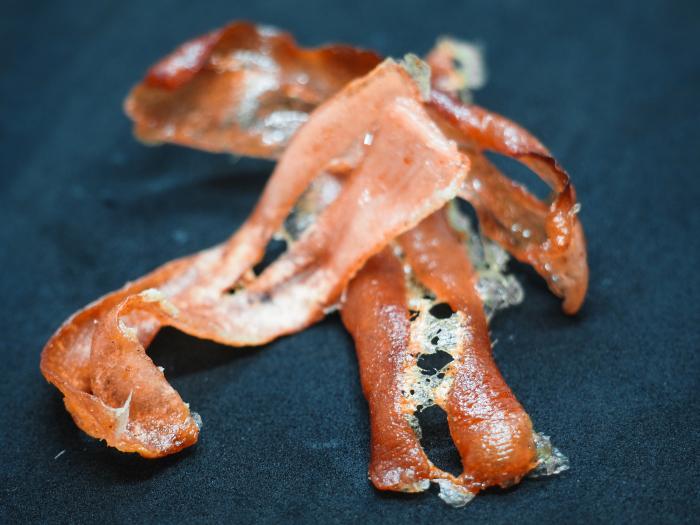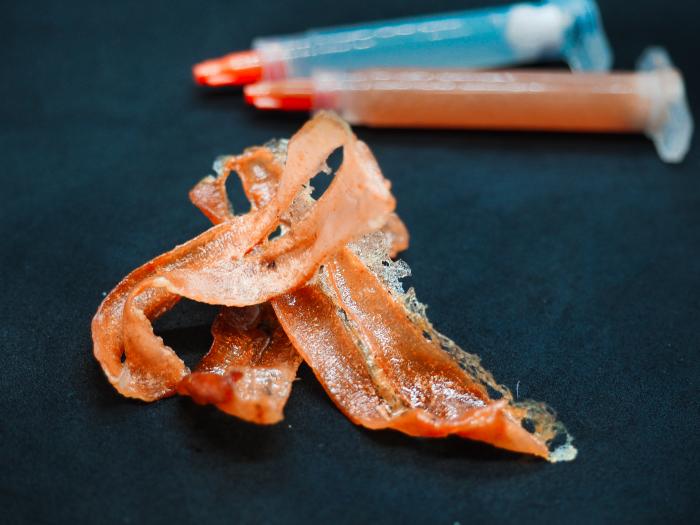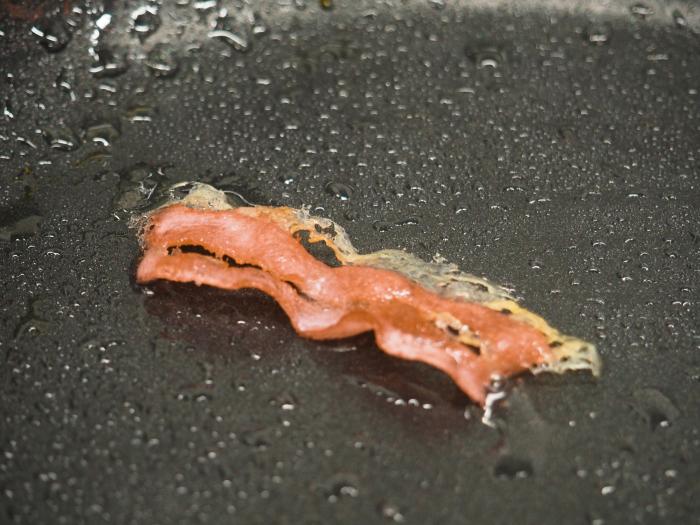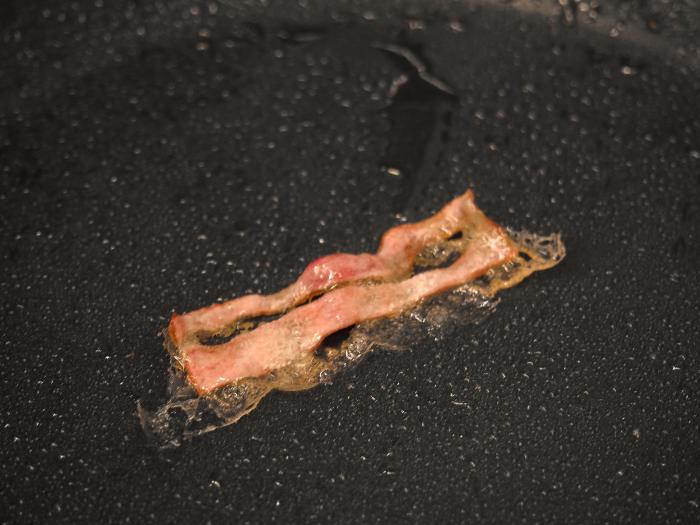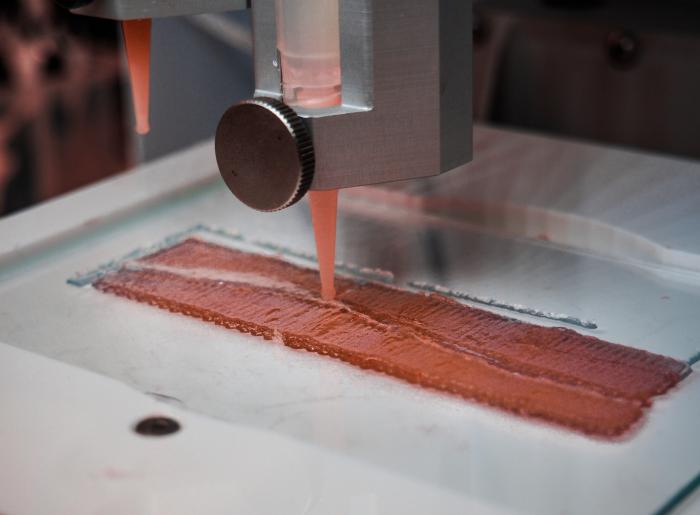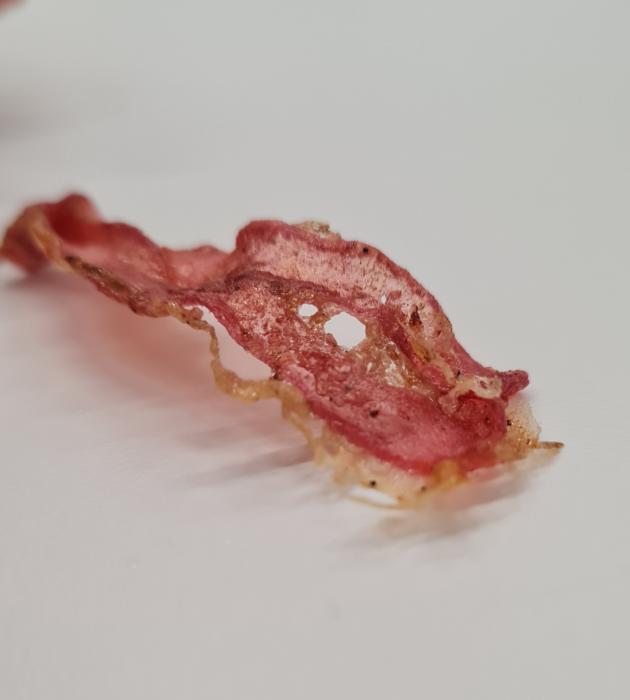I. SUMMARY INFORMATION
Project
267547
Status
Submitted
Award category
Products and life style
You want to submit
NEW EUROPEAN BAUHAUS AWARDS : existing completed examples
Project title
Print. Fry. Eat
Full project title
Plant-based fryers that taste, smell, feel and fry like bacon.
Description
We want to provide customers with a plant-based alternative to bacon that does not compromise on experience. Therefore, we developed a plant-based product that covers all sensory aspects of eating and cooking with ordinary bacon. We use a variety of hydrogels and combine them via multi-material printing in a pattern resembling bacon’s structure and texture. The final product curls and shrinks during frying as bacon would, moreover it provides a great flavour and mouthfeel.
Where was your project implemented in the EU?
Denmark
Funen
Campusvej 55
Odense
5230
When was your project implemented?
Has your project benefited from EU programmes or funds?
No
Which programme(s) or fund(s)? Provide the name of the programme(s)/fund(s), the strand/action line as relevant and the year.
II. DESCRIPTION OF THE PROJECT
Please provide a summary of your project
Animal-based protein foods, such as meats and fish, play a prominent role in cooking practices. Recent developments in animal welfare and CO2 emissions call for a reduction in consumption. However, meats and fish have rich gustatory properties (as they offer a great variety in combinations of muscle tissue, fats and connective tissue. Many meat alternatives available commercially provide the customer with a very similar texture and flavour of meat, Unfortunately, many don’t take into account the cooking process and playful interaction with food during cooking.
When developing this product, we wanted to address all multi-sensorial experiences of cooking and eating bacon. We aimed to develop a product, that looks, tastes, and behaves like bacon.
To do so we used a variety of hydrogels, which were combined via multilateral print to create plant-based bacon that changes its shape by curling during cooking similarly to pork bacon. The flavour was achieved by mixing common spices and presence aromas created by the Maillard reaction. Our product provides a great alternative to animal-based bacon, and it does not compromise on flavour and experience.
Hydrogels have very diverse properties depending on the polymers used and they showed a great variety of textures. We believe they can have further potential to be used as a plant-based meat alternative, possibly with the addition of extra ingredients.
Please give information about the key objectives of your project in terms of sustainability and how these have been met
In many cultures meat is considered an essential part of a diet and many traditional recipes build on animal-based protein. Given increasing standards of living and a rapidly growing population, the consumption of meat has been growing substantially. This development has a negative impact on the environment and climate and called for an increase in plant-based diets such as vegetarianism and veganism to reduce meat intake and thereby slow down climate change. As a consequence, the demand for and development of alternative meat products has been rising.
Plant-based hydrogels are also often made from seaweeds, like brown and red algae. In general, algae is considered a sustainable food source, it grows quickly, requires only sunlight to grow, purifies the water it grows in. In comparison, 1 kg of pork produced generates about 7-8 kg of CO2e, meanwhile, seaweed absorbs CO2 to grow. Therefore, it is seen as a sustainable and healthy addition to the European diet.
Moreover, producing meat alternatives within lab conditions makes food production non-dependent on environmental changes, it allows to control the growth rate and reduce the water footprint.
Please give information about the key objectives of your project in terms of aesthetics and quality of experience beyond functionality and how these have been met
While the taste and texture of protein alternatives are crucial for their acceptance, their preparation also contributes to forming an experience around food and eating. Physical and chemical changes in food, during their preparation, do not only affect their texture and flavour but also our experiences and expectations of food. Researchers have investigated how creativity can support novel food practices that enrich interactions with food. For instance, playful gastronomy and eating practices, sensory-rich cooking practices, engagement with material (food) and use of new/smart technologies in the kitchen and at the table. Unfortunately, some of this playful sensorial experience can be lost when preparing a meal with plant-based meat substitutes which do not react to the cooking process the same way real meat does. Therefore, we have developed a product which not only provides a great texture and flavour of bacon but also has a similar cooking behaviour.
In this case, the customer undergoes the full experience of cooking and interacting with the developed food product.
Please give information about the key objectives of your project in terms of inclusion and how these have been met
In terms of inclusion, the product can be enjoyed not only by people on plant-based or vegetarian diets but also by people who prefer not to eat pork or by regular customer who are searching for new food experiences.
However, at this moment the would be difficult to mass-produce since it is made using 3D printing technology. Despite many advantages, 3D printing is time-consuming and often hard to scale to larger production quantities. Therefore, at this stage, this product is mostly meant for the more niche markets. For instance, restaurants or a small production on request. The product itself takes about 60 seconds to be produced/printed, however, there is a lot of manual steps involved to move to the next print. This process can be automated in the future, this would speed up the production rapidly.
Please give information on the results/impacts achieved by your project in relation to the category you apply for
We are all encouraged to cut meat consumption and plant-based diets such as vegetarianism and veganism are being actively promoted. Despite many people being encouraged to change their lifestyle, some become opposed to those views and refuse to change or even try plant-based alternatives. Primarily, because the product doesn’t look, smell. Taste or behave like the imitated product.
Of course, our product can be a great addition to any plant-based diet. However, our aim is to provide people with an attractive alternative to bacon, not a substitution for it. If a consumer is presented with an attractive alternative and not forced to give up the original product, they might be more open to trying it either out of curiosity, health, or climate change concerns.
Please explain the way citizens benefiting from or affected by the project and civil society have been involved in the project and what has been the impact of this involvement on the project
In order to test the textural aspect and flavour profile of the bacon, we have conducted sensory panel tests to get feedback from the potential user. Unfortunately, due to the pandemic, the sample size of the group was relatively small (5 people), however, we got good feedback and used it to improve the flavour profile of the printed bacon.
We have also conducted a few user tests, where we have asked participants to cook with the bacon. Even though the cooking procedure is a bit different from the pork bacon (the temperature is lower at first and increases towards the end of the frying), the participant found it entertaining and involving.
We hope that in September-November 2021 we will be able to conduct more evaluations and involve more participants to receive more feedback on our development
Please highlight the innovative character of the project
As we have already mentioned, we have developed a product which reacts to heat.
This was done as a part of the exploration of edible materials with pre-programmed behaviour or edible smart materials. We believe that many domains can benefit from stimuli-responsive or smart foods. They could provide novel mouth experiences for people with swallowing disorders or improve the quality and experience of meat alternatives. This project was a starting point for us to start working in the area of smart foods and demonstrate its potentials to the consumer and industry.
Moreover, the chosen material – hydrogels, are not common to be used for meat substitutes. However, they have many potential health benefits (depending on what polymer was used to make the hydrogel). For instance, the polymers we have used were low in calories and fat, but they contained a high amount of dietary fibre. In Europe, the average intake of fibre is 18 to24 g per day and for females 16 to 20g per day, while the recommended intake is 30–35 g per day for men and 25–32 g per day for women, the undertake of fibre can result in some serious health complications, like increased cholesterol, different types of cancer, diverticulosis, and others. Therefore, introducing hydrogels with a high concentration of fibre into our diets through the creation of appetizing and familiar snack might increase daily fibre intake and result in better customer acceptance due to added health benefit.
Please explain how the project led to results or learnings which could be transferred to other interested parties
The idea of not only developing the taste and texture of the food product but also the way the product behaves when cooked can be transferred and used by any company working in food innovation and products development.
The use of the food as a smart or -preprogrammed material, is currently getting more attention from the researcher, who are curious to experiment and explore this topic. Depending on the chosen stimulus (heat, water, acidity) material can have different shape-changes and those can be applied in different sectors. There are potentials to expand this topic to the medical sector (e.g. edible medical robots), transportation (flat-packaging) or for now multi-sensorial experiences in the restaurants.
Is an evaluation report or any relevant independent evaluation source available?
No
III. UPLOAD PICTURES
IV. VALIDATION
By ticking this box, you declare that all the information provided in this form is factually correct, that the proposed project has not been proposed for the Awards more than once under the same category and that it has not been subject to any type of investigation, which could lead to a financial correction because of irregularities or fraud.
Yes
